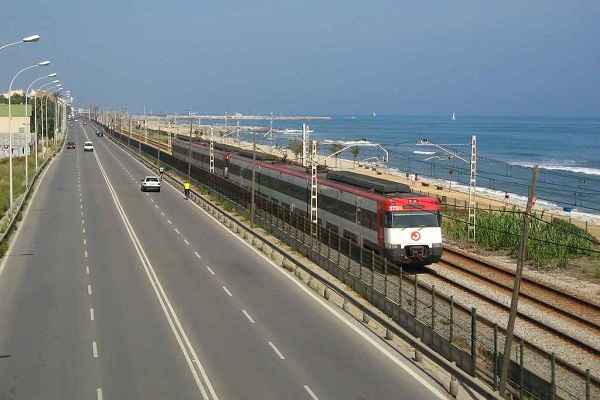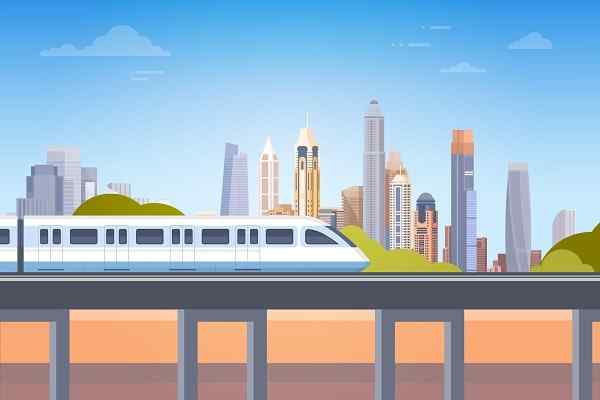 Delhi unveils ambitious Urban Mobility Vision: Luxury Metro Coaches, New Tunnels and Pod Taxi
Delhi unveils ambitious Urban Mobility Vision: Luxury Metro Coaches, New Tunnels and Pod Taxi Qatar approves Saudi Rail Link Agreement, Accelerating Gulf Railway Vision 2030
Qatar approves Saudi Rail Link Agreement, Accelerating Gulf Railway Vision 2030 UP Govt plans to introduce Water Metro services in Ayodhya, Varanasi & Prayagraj
UP Govt plans to introduce Water Metro services in Ayodhya, Varanasi & Prayagraj India’s First Urban Ropeway begins Trial Run in Varanasi, Set to carry 1 Lakh passengers daily
India’s First Urban Ropeway begins Trial Run in Varanasi, Set to carry 1 Lakh passengers daily India and Bhutan to Build First-Ever Rail Link: ₹4,033 Cr Project to Boost Regional Connectivity
India and Bhutan to Build First-Ever Rail Link: ₹4,033 Cr Project to Boost Regional Connectivity Patna to launch Eco-Friendly Water Metro; Trial Run soon between Digha and Kangan Ghats
Patna to launch Eco-Friendly Water Metro; Trial Run soon between Digha and Kangan Ghats Air India Group set to launch Flights Operations from Navi Mumbai International Airport
Air India Group set to launch Flights Operations from Navi Mumbai International Airport Chennai to launch 25-Year Mobility Plan with Unified QR Ticketing and One-App Transit System
Chennai to launch 25-Year Mobility Plan with Unified QR Ticketing and One-App Transit System Kochi Metro bags ₹4.4 crore contract to prepare DPR for Mumbai Water Metro Proejct
Kochi Metro bags ₹4.4 crore contract to prepare DPR for Mumbai Water Metro Proejct Navi Mumbai International Airport set for September launch; IndiGo and Akasa Air to lead Operations
Navi Mumbai International Airport set for September launch; IndiGo and Akasa Air to lead Operations
India unveils $240 billion Investment Plan to transform Roads and National Highways

New Delhi, India (Urban Transport News): In a monumental move aimed at revolutionizing India's transportation landscape, Prime Minister Mr. Narendra Modi's government has unveiled a groundbreaking plan to invest a staggering US$ 240 billion (Rs. 20 lakh crore) in a comprehensive highway development initiative. The Ministry of Road Transport and Highways has laid out an ambitious blueprint, targeting the construction and expansion of approximately 41,000 km of national highways, with a special emphasis on creating 15,000 km of high-speed, access-controlled corridors by the fiscal year 2031-32.
Visionary Roadmap
This visionary initiative, projected to require an estimated investment of US$ 234.4 billion (Rs. 19.5 lakh crore), is poised to redefine the way India travels. According to sources, the proposed master plan envisions the commencement of bidding for initial phase projects by 2028-29, with completion anticipated by 2031-32.
The heart of this transformative program lies in its goal to nearly double the average travel speed on the National Highway (NH) network. The current speed of 47 kmph is set to soar to an impressive 85 kmph, placing India in league with international standards. For context, highways in the US boast an average speed exceeding 100 kmph, while China maintains a speed of 90 kmph.
| SNo | Category | Phase 1 | Phase 2 | Total (Kilometres) |
| 1. | High Speed Corridor | 15,246 | 21,296 | 36,542 |
| 2. | Upgradation of Roads to 2-Half Lanes | 11,179 | 19,448 | 30,627 |
| 3. | Remaining Projects from Bharatmala-I | 6,777 | NA | 6,777 |
| 4. | Spur & Feeders to Economic Hubs | 2,894 | 3,195 | 6,089 |
| 5. | Strategic/International Roads | 2,379 | 2,841 | 5,220 |
| 6. | Decongestion of NHs around cities | 1,044 | 3,000 | 4,004 |
| 7. | Port Connectivity | 1,607 | NA | 1,607 |
| Total (Kilometres) | 41,126 | 49,780 | 90,906 |
[Source: TOI]
Speeding Towards Economic Growth
The overarching objective of this highway development initiative is not only to enhance travel speed but also to significantly reduce logistics costs. The government aims to slash these costs from the current 18% of the GDP to a mere 9-10%. This reduction is anticipated to be achieved through a substantial increase in travel speed.
To ensure seamless accessibility, specific high-speed corridors have already been identified within a range of 100-150 km from any part of India. This strategic planning is aimed at alleviating congestion in and around cities and urban areas. Currently, only 3,900 kilometers of high-speed corridors are operational, but projections indicate a substantial rise to around 11,000 kilometers by 2026-27. The Ministry foresees the need for approximately 50,000 km of high-speed corridors to meet the outlined objectives.
Bridging the Infrastructure Gap
Recognizing the significant gap in existing infrastructure, the government has earmarked new high-speed corridors covering 36,500 kilometers. Over the next two decades, the primary focus will be on the construction of four and six-lane highways, according to official sources. This comprehensive approach is set to address congestion issues and enhance the overall efficiency of transportation networks.
A Stride Towards Economic Development
This ambitious proposal represents a significant stride in enhancing India's transportation infrastructure, aligning seamlessly with the government's vision for robust economic development and reduced logistics costs. As the country gears up for a transformative era in travel, the impact on commerce, trade, and overall economic growth is anticipated to be profound.
Prime Minister Narendra Modi-led government has set the wheels in motion for a transformative journey in India's transportation sector. The US$ 240 billion highway plan is not merely an investment in roads; it's an investment in the nation's economic future. As India accelerates towards higher travel speeds and lower logistics costs, the ripple effects on commerce and trade are poised to shape a new era of prosperity.







